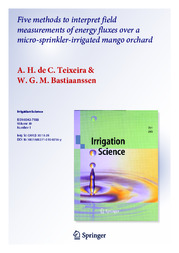Five methods to interpret field measurements of energy fluxes over a micro-sprinkler-irrigated mango orchard.
Five methods to interpret field measurements of energy fluxes over a micro-sprinkler-irrigated mango orchard.
Author(s): TEIXEIRA, A. H. de C.; BASTIAANSSEN, W. G. M.
Summary: Energy balance measurements were carried out in a mango orchard during two growing seasons in the semi-arid region of Brazil. The actual evapotranspiration (ET) was acquired by eddy correlation (EC) and Bowen ratio energy balance (BR) techniques. The daily energy balance closure in the EC measurements showed an average gap of 12%, with a root mean square error (RMSE) of 1.7 MJ m-2 d-1. Three different correction procedures were tested for closing the energy balance from the EC system: (1) the surface energy balance residual method (RES), (2) the Bowen ratio determined from the EC fluxes, the combination approach (EC_BR), and (3) a new regression energy balance closure technique (REG). All closing energy balance methods presented good correlation with the direct EC measurements, but the trends were not similar. The latent heat fluxes estimated by the BR method—kEBR —were higher than those from the direct EC measurements—kEEC. When using the RES method, the half-hour kEEC measurements represented around 88% of the kERES values, as the uncertainties of net radiation— Rn —and soil heat fluxes—G—are propagated into the RES method. The latent heat flux derived from the combination approach—kEEC_BR —also brings these uncertainties, being the agreements comparable with those for RES method. It was therefore concluded that a single correction method for EC measurements considering only the latent and sensible heat fluxes does not exist. A new way to solve the lack of energy balance closure from EC techniques was tested by means of a curve fitting, the REG method. Considering the REG corrections applied to the energy balance components involving all periods of the day and the average conditions of the two growing seasons, half-hour values of kEEC were overmeasured by 18%, HEC was undermeasured by 17%, and G values required a correction of 466%. The REG method appeared promising because it considers different weights for all energy balance components in the optimi- zation process. Taking the REG results for the drier second growing season as a reference, it was concluded that seasonal ET values by the other methods in mango orchard ranged from 7 to 28% higher, showing that turbulent flux measurements lack accuracy for executing on-farm water-saving programmes and calibrating transient soil water flow models.
Publication year: 2012
Types of publication: Journal article
Unit: Embrapa Semi-arid Region
Keywords: Balanço de Energia, Evapotranspiração, Irrigation, Irrigação, Manga, Mangoes, Pomar de manga
Observation
Some of Embrapa's publications are published as ePub files. To read them, use or download one of the following free software options to your computer or mobile device. Android: Google Play Books; IOS: iBooks; Windows and Linux: Calibre.
Access other publications
Access the Agricultural Research Database (BDPA) to consult Embrapa's full library collection and records.
Visit Embrapa Bookstore to purchase books and other publications sold by Embrapa.

